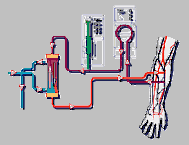“Football and
Dialysis”
or
The “Agar Patented Explanation” of:
How Dialysis Works
(With apologies to the Geelong Football Club)
Imagine an Australian Rules Football Oval, though any football arena would do…
Out in the middle… The Geelong Cats are warming up like a well-oiled machine!
• There are two equal sized spectator areas
• The two enclosures are separated by a chain-mesh fence
• Each enclosure has a locked gate awaiting the gatekeeper to arrive
• The gate-keeper of one enclosure opens the gate letting in the Cats fans, adults and kids
But
• The other gatekeeper sleeps in. His gate stays locked.
• All the supporters are therefore crowded into the one enclosure!
|
G
GO CATS
GO CATS
|
|
☺☺☺☺☺☺ JJJJJJ ☺☺☺☺☺☺ JJJJJJ ☺☺☺☺☺☺ JJJJJJ
|
|
|

This causes problems
• The kids can’t see the game over the adults heads
• Kids being kids, some see the holes in the chain-mesh fence … and what would YOU do if you were a small kid?
The result
• They begin to crawl through the holes leaving the adults in the other enclosure.
• Over time, the number in each enclosure would equalize, giving the best view to all
|
☺J |
|
JJJJJJ ☺☺☺☺☺☺ JJJJJJ
|
|
☺☺☺☺☺☺
☺☺☺☺ ☺☺☺☺ |
| GO CATS |
| GO CATS |

But not everyone is happy
• The police are furious ... kids can’t do that!
• They arrest the kids and take them away
• Suddenly … one enclosure is empty again
|
|
|
JJJJJJ ☺☺☺☺☺☺ JJJJJJ |
|
|
|
LL |
|
|

And the cycle continues
• The remaining kids with the adults can’t resist the holes in the fence and the empty enclosure
• The Cats are ‘on fire’ and they want a better view!
• As the police leave with the first ‘offenders’ …
• The remaining kids crawl through the fence to get a better view of the game
• As they do, the number staying with the adults falls even further
|
☺ ☺
|
| J☺JJ☺J JJJJJJ
|
|
☺☺☺☺
☺☺☺ ☺☺☺ |

So … what is the principle happening here?
• During the game, the smaller people cross through the fence for a better view but are constantly removed by the police
• By game’s end, both enclosures are emptied of ‘small people’ by:
(i) a constant escape through the fence - (this demonstrates the "Principle of Diffusion")
(ii) a constant removal by the police
In dialysis…
• Like we have just seen occurring in the example of the football crowd, a crowd in any crowded space will tend to disperse to a less crowded space if any barrier separating the two spaces can be crossed
• So... if blood which contains high levels of waste (as in kidney failure) can be brought close to a fluid containing no waste, and if the blood and fluid compartments can be separated by a leaky membrane with tiny holes in it across which some of the waste can freely pass, wastes would move through the membrane from the blood into the fluid
• Small wastes would ooze through the holes in the membrane and into the waste-free fluid on the other side... just like the kids crawled through the wire-mesh fence in our example
• If the fluid in the fluid compartment is consistently removed and renewed with fresh, waste free fluid, a continual gradient is created down which more small wastes flow
• So... slowly, the blood is cleansed of its high waste levels

This example of the football crowd serves to illustrate how dialysis works.
• Small wastes pass across a ‘permeable’ membrane and are constantly ‘removed’
• Over time, the blood is slowly cleared of waste material
• However, bigger wastes remain a problem as they take much, much longer to ‘pass through’.
As a result, time on dialysis actually does matter!
• Not all wastes are small in size
• Some wastes are big and find it much harder and also take longer to squeeeeeeze through the holes in the fence
• The bigger sized wastes therefore need either…
• Considerably more time
• A leakier membrane
• … or both!
On two counts, therefore …Time on dialysis matters
Authored by Prof John Agar. Copyright © 2012
Nocturnal Haemodialysis Program, Barwon Health.
All rights reserved. Revised: July 1st 2012